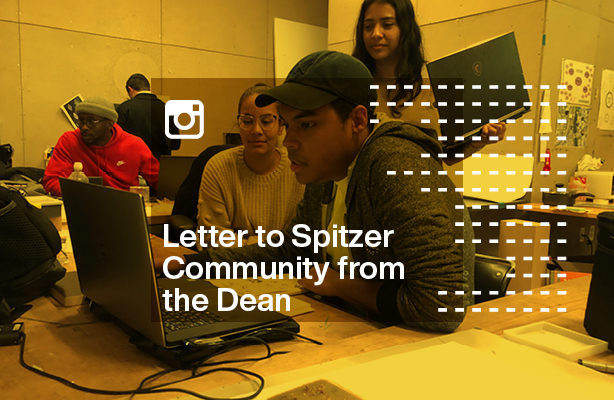News
Letter to the Spitzer Community
Dear Spitzer School of Architecture Community,
This has been a terrible, tragic week for America. I will ask you in advance to forgive the observations of an outsider and newcomer, on the one hand, and the dean of this institution who is black, on the other. This rare duality makes for an uneasy balance. I’m speaking to you today publicly, not privately, but the duality of being a black leader in a moment like this means I cannot adhere to the usual professional and polite separation of private/public. I have been writing this letter to you all since 6:30am. At 10:08am, Prof Marta Gutman e-mailed me, asking me if I intended to make a statement. It’s now 12:11pm.
Over the past week, as a community, we have come together several times to celebrate and honor each other’s resilience and commitment. In those celebrations, we’ve largely steered clear of overt critique or self-analysis, ostensibly out of etiquette. In response to statements or presentations made, I’ve been gently reminded several times that this not the time or place to be critical. Support is what is required and the best way to support Americans in times like these is to cheer them on, cheer them up. This is a society of winners. What’s required is a focus on the good times, not the bad.
Over this same past week, however, I’ve also been party to an entirely different kind of conversation that’s been taking place largely within black America, privately, in Zoom calls, phone calls, through WhatsApp messages containing links to other messages, chat groups and articles. What emerges from these conversations is not a society of winners, but of survivors. Winners and survivors. The image burns my retina: is basic and brutal survival the price of success?
At the risk of repeating myself, I want to share with you two things I said at the Spitzer Summer Show on Wednesday, 27 May, 2020
“There is the appetite for change here at Spitzer— perhaps not quite as much as I imagined — but there’s also a great deal of hesitancy, some of which has to with wider questions about education, the economy, and so on, which have been exacerbated by COVID. I believe the hesitancy on the part of our students has to do with questions about our disciplines, about its relevance and whether what and how we teach either prepares students for the ‘world outside’ (which is no longer quite as ‘outside’ the academy or the university as it once was) or resonates meaningfully with them in the first place. The Brazilian philosopher, Roberto Mangabeira Unger once wrote, ‘the trouble with contemporary architecture has three sources: one is artistic, the absence of any canonical set of forms; the second is in engineering, the failure of physical constraints to determine the shape of buildings and the third is social; the inability of any one group in society to get its anxieties recognized as the ones that count.’ I read that as a student of architecture in 1991. His last point was true then, and I believe it’s still true now. What matters now?”
“I’d like to end my bit this evening by quoting T’Challa. ‘Now, more than ever, the illusions of our division threaten our existence. We all know the truth. More connects us than separates us. But in times of crisis, the wise build bridges while the foolish build barriers.’ Kindness and tolerance may be old-fashioned and perhaps even naïve but they’re the tools for bridge-building that generations before us have used to construct lives worth living. Cynicism and disdain may be fashionable but they build little other than mutual mistrust. I hope 2020 will be a better year, not just because we overcame the threat of COVID, but because we overcame the threat of each other.”
I have neither the capacity nor the patience to end this message on the usual high notes of optimism and cheer. In the many responses from many leaders that I’ve seen recently, I note the long lists of resources, links and further readings; the pre-packaged, corporate statements on diversity and inclusivity, which I read whilst watching Killer Mike, a black man and the son of an Atlanta city police offer, address a crowd: ‘I have nothing positive to say in this moment. I don’t want to be here. But I have a responsibility to be here because it wasn’t just Dr King and people dressed nicely who marched in protest to progress this society. I am duty-bound to be here today to simply say, “it is your duty not to burn your own house down. It is your duty to fortify your house so that you may be a house of refuge.”’
Watch it here: https://twitter.com/mentnelson/status/1266562774118907904?s=12
Our school is our house. What will we do to fortify it? How can this school be a house of refuge?
Toni Morrison, on whose words we ended the Spitzer Retrospective on Wednesday night, says it simply and clearly.
This is the time when artists go to work. Not when everything is alright, when it’s sunny. It’s when it’s hard.
Please begin by building with me a Schindler’s List of resources. E-mail me your recommendations. Readings. Films. Articles. Books. Drawings. These can be as extensive or as short as you like.
This is the second “open call” in a month. Mail your suggestions and recommendations to Erica and I. We will build this list on social media, in our library, in our offices, in classrooms and on our website. We will archive and structure the material. When we reopen in August, we will have found ways to use the list productively, privately and publicly.
It will not change the world.
Thank you,
Professor Lesley Lokko, Dean
The Bernard and Anne Spitzer School of Architecture
City College of New York


